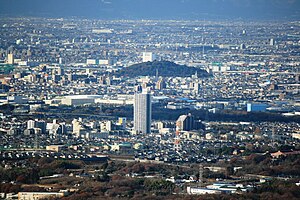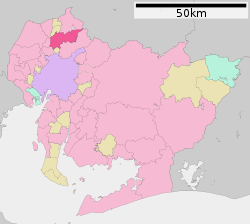| Komaki 小牧市 | |
|---|---|
| City | |
  Upper:Komaki Castle Upper:Komaki CastleLower:Komaki Skyline | |
 Flag Flag Seal Seal | |
 Location of Komaki in Aichi Prefecture Location of Komaki in Aichi Prefecture | |
 | |
| Coordinates: 35°17′27.6″N 136°54′43.6″E / 35.291000°N 136.912111°E / 35.291000; 136.912111 | |
| Country | Japan |
| Region | Chūbu (Tōkai) |
| Prefecture | Aichi |
| Government | |
| • - Mayor | Suzuo Yamashita |
| Area | |
| • Total | 62.81 km (24.25 sq mi) |
| Population | |
| • Total | 148,872 |
| • Density | 2,400/km (6,100/sq mi) |
| Time zone | UTC+9 (Japan Standard Time) |
| - Tree | Tabunoki (Machilus thunbergii) |
| - Flower | Azalea |
| Phone number | 0568-72-2101 |
| Address | 1-1 Horinouchi, Komaki-shi, Aichi-ken 485-8650 |
| Website | Official website |
Komaki (小牧市, Komaki-shi) is a city located in Aichi Prefecture, Japan. As of 1 October 2019, the city had an estimated population of 148,872 in 68,174 households, and a population density of 2,370 inhabitants per square kilometre (6,100/sq mi). The total area of the city was 62.81 square kilometres (24.25 sq mi). Komaki is commonly associated with the former Komaki Airport, which is located on the border between Komaki and neighboring Kasugai.
Geography

Komaki is located in the middle of the Nōbi Plain, west-central Aichi Prefecture, north of the Nagoya metropolis. The city skyline is dominated by Mount Komaki, which is topped with Komaki Castle.
Climate
The city has a climate characterized by hot and humid summers, and relatively mild winters (Köppen climate classification Cfa). The average annual temperature in Komaki is 15.7 °C (60.3 °F). The average annual rainfall is 1,769 mm (69.6 in) with September as the wettest month. The temperatures are highest on average in August, at around 28.1 °C (82.6 °F), and lowest in January, at around 4.2 °C (39.6 °F).
Demographics
Per Japanese census data, the population of Komaki has increased rapidly over the past 60 years.
| Year | Pop. | ±% |
|---|---|---|
| 1960 | 43,470 | — |
| 1970 | 79,606 | +83.1% |
| 1980 | 103,233 | +29.7% |
| 1990 | 124,441 | +20.5% |
| 2000 | 143,122 | +15.0% |
| 2010 | 147,059 | +2.8% |
Surrounding municipalities
| Places adjacent to Komaki | ||||||||||||||||
|---|---|---|---|---|---|---|---|---|---|---|---|---|---|---|---|---|
| ||||||||||||||||
History


Ancient history
Archaeological remains from the Japanese Paleolithic through Yayoi period have been found in what is now Komaki, and burial tumuli from the Kofun period are also common.
Feudal period
During the Sengoku period, Oda Nobunaga used Komaki Castle as his headquarters from which he launched his invasion of Mino Province and later the area surrounding Mount Komaki was the site of the Battle of Komaki and Nagakute in 1584.
Early modern period
It was part of the holdings of Owari Domain during the Edo period, and prospered as a post town on the route connecting Nagoya with the Nakasendō highway.
Late modern period
During the Meiji period establishment of the modern municipalities system, the area was organized into villages under Higashikasugai District, Aichi. Komaki was proclaimed a town on July 16, 1906, through the merger of four villages.
Contemporary history
Komaki was raised to city status on January 1, 1955, after merging with the village of Kitasato in Nishikasugai District, Aichi.
Government

Komaki has a mayor-council form of government with a directly elected mayor and a unicameral city legislature of 25 members. The city contributes two members to the Aichi Prefectural Assembly. In terms of national politics, the city is part of Aichi 16th district of the lower house of the Diet of Japan.
Sister cities
International
- Sister cities
 Wyandotte (Michigan, United States, since March 22, 1967. Each year, Wyandotte and Komaki have an exchange student program, allowing students to be hosted by a family in the other city.
Wyandotte (Michigan, United States, since March 22, 1967. Each year, Wyandotte and Komaki have an exchange student program, allowing students to be hosted by a family in the other city.
- Friendship city
 Anyang,Gyeonggi Province, South Korea, since August 1979 (friendship city since 1986)
Anyang,Gyeonggi Province, South Korea, since August 1979 (friendship city since 1986)
National
- Friendship city
 Yakumo, Oshima Subprefecture, Hokkaido, since October 24, 1986
Yakumo, Oshima Subprefecture, Hokkaido, since October 24, 1986
Economy


Komaki has a mixed economy, with agriculture (rice and horticulture), commence, and light manufacturing industries playing important roles.
Komaki's GDP per capita (Nominal) was ¥5,859,100 in 2014.
Primary sector of the economy
Agriculture
Poultry farming
Secondary sector of the economy
Manufacturing
Sumitomo Riko (Previously known as Tokai Gomme), a global rubber and synthetic resin products manufacturing company, whose automotive anti-vibration components hold the largest global market share, has its headquarters in the city.
Tertiary sector of the economy
Commerce
Due to its highway connections with the Nagoya metropolis, it is also becoming a bedroom community.
Companies headquartered in Komaki
- COMO
- SATO FOODS INDUSTRIES
- santec
- CKD Corporation
- Sumitomo Riko
- Taihei Machinery Works
- Tsunoda Co
- HOUTOKU Co
-
 COMO
COMO
-
SATO FOODS INDUSTRIES
-
CKD Corporation
-
Sumitomo Riko
-
 Tsunoda
Tsunoda
-
HOUTOKU Co
Education
Universities
Schools
- Elementary and secondary education
Komaki has 16 public elementary schools and nine public junior high schools operated by the city government, and three public high schools operated by the Aichi Prefectural Board of Education. There is also one private high school. The prefecture also operates one special education school for the handicapped.
International School
- The Colégio Dom Bosco, a Brazilian school was formerly located in Komaki.
Transportation

Airways
Airports
Railways
Conventional lines
- Komaki Line: - Komakiguchi - Komaki - Komakihara - Ajioka - Tagata-jinja-mae -
The Peachliner, formally the Tōkadai Shin-kōtsū Peach Liner (桃花台新交通ピーチライナー) was a people mover which operated from 1991 until September 30, 2006, when it became the first people-mover system in Japan to cease operations.
Roads
Expressways
 Chūō Expressway
Chūō Expressway Meishin Expressway (Asian Highway Network)
Meishin Expressway (Asian Highway Network) Tōmei Expressway (Asian Highway Network)
Tōmei Expressway (Asian Highway Network) Route 11 (Nagoya Expressway)
Route 11 (Nagoya Expressway)
Japan National Route
Local attractions

- Historic sites
- Iwaya Kofun
- Komaki shuku (Kishida house)
- Mount Komaki (Komaki Castle)
- Ryūon-ji temple (Mama Kannon)
- Shinooka Kiln ruins
- Tagata Jinja
-
 Komaki Castle museum
Komaki Castle museum
-
 Ryūon-ji
Ryūon-ji
(Mama Kannon) -
 Tagata Jinja
Tagata Jinja
-
Komaki-shuku
-
 Iwaya Kofun
Iwaya Kofun
-
Shinooka kiln ruins
- Parks
- Menard Art Museum
- Komaki Municipal Baseball Stadium
- Park Arena Komaki
- Shimin Shiki no Mori
Culture
Festivals
- Hōnen Matsuri, and annual fertility festival held on March 15 at Tagata Shrine.
- Bamboo Installation
Sports
| Sex | Name | competition | League | Home | Sponsor | Since |
|---|---|---|---|---|---|---|
| Men | Nagoya Diamond Dolphins | Basketball | B.League (B1) | Dolphins Arena Park Arena Komaki |
Nagoya Diamond Dolphins (Mitsubishi Electric) |
1950 |
| Men | Nagoya Oceans | Futsal | F.League | Takeda Teva Ocean Arena Park Arena Komaki |
Teva Takeda Pharma | 2006 |
Noted people from Komaki
- AK-69, hip-hop artist
- Kohei Hirate, professional race car driver
- Miku Ishida, singer, gravure artist
- Masanari Omura, professional footballer
- Minoru Tanaka, professional wrestler
- Asuka Teramoto, Olympic gymnast
- Jōtarō Watanabe, Imperial Japanese Army general
References
- "Komaki City official statistics" (in Japanese). Archived from the original on 2019-10-23. Retrieved 2019-10-23.
- "Komaki climate data".
- Komaki population statistics
- "International Exchange". List of Affiliation Partners within Prefectures. Council of Local Authorities for International Relations (CLAIR). Archived from the original on 24 December 2015. Retrieved 21 November 2015.
- "Komaki:Interaction with Yakumo". Archived from the original on 2017-03-20. Retrieved 2021-09-09.
- 市民所得 [Citizen Income] (PDF). Archived from the original (PDF) on 22 August 2018.
- "Komaki Population (December 2014)". 1 December 2014.
- "Business Locations". Sumitomo Riko. Archived from the original on 12 November 2020. Retrieved 11 November 2020.
- "Escolas Brasileiras Homologadas no Japão" (Archive). Embassy of Brazil in Tokyo. February 7, 2008. Retrieved on October 13, 2015.
- Peachliner home page Archived 2018-12-15 at the Wayback Machine (in Japanese)
External links
- Komaki City official website (in Japanese)
| Nagoya (capital) | ||||
| Nagoya |
| |||
| Core cities | ||||
| Special city | ||||
| Cities | ||||
| Districts | ||||
| Former Districts | ||||











